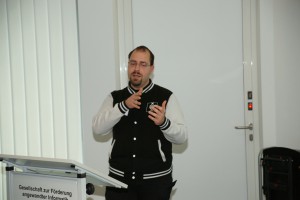As in every discipline, the end of the year means also a time for research community gatherings, workshops and forth-so. For my part, this means to traditionally attend the 3D NordOst workshop on applied graphics, visualisation, processing and interaction of 3D data in Berlin/Adlershof. This venue is hosted for several years by the GFaI (Gemeinschaft zur Foerderung angewandter Informatik; engl.: Association for the Valorisation of Applied Informatics) in Berlin, taking place annually at the beginning of Decembre.
As most years in the past, I presented some more application-oriented results of my algorithmic research, which I presented in the „Algorithms/Calibration“ track. As this year’s research was mostly steered towards Image-to-Geometry registration, I presented an algorithmic comparison of different numerical schemes for pose estimation. A fun-fact aside is that, by now, I have 4 conference badges of former years, each marking a different university on it. Perhaps we keep this „fun-run“ in upcoming years 😉

paper presentation at 3D NordOst 2015
The workshop itself was featured with a very familiar atmosphere – although there are newcomers every year (as in every subject and discipline), the major participating institutes (TU Dresden, University Duisburg-Essen, Otto-von-Guericke University Magdeburg, Humboldt University Berlin, HTW Berlin, Fraunhofer Institute, DLR, and the GFaI) still prevail, and certain researchers (Prof. Ralf Reulke, Mirko Riedel, Prof. Thomas Jung, me) are also regular attendees at the venue. What I missed this year, a bit, was a contribution from Rostock (Fraunhofer IGD/University Rostock) and Duisburg (w.r.t. Rapid Prototyping and CAD). Also, as this is a good opportunity to showcase work from applied universities, more contributions from Wismar, Neubrandenburg, Potsdam and Brandenburg would be pleasant in the coming years – their attending has already been more in the past …
In general, the workshop took this year a strong drift into strict Photogrammetry, presenting numerous handcraft, low-cost 3D scanning solutions. The majority of the papers focussed on traditional photogrammetric issue, such as measurement accuracy and calibration issues. It is certainly an interesting drift, were my article (which this year also deviated considerably from my typical research) fitted in quite well by chance – it actually suited much more than I commonly expected. 3D graphics topics such Big Data rendering, modern registration methods or visualisation/visual analytics still have it difficult at the venue. This may or may not change in the coming years.
Certain articles of considerable mention and interest, from my perspective, were part of the „Algorithms/Calibration“ section as well as some very interesting applications. A non-pinhole calibration model (with focus on outdoor use of specialised cameras) was presented by the HU Berlin, while researchers from the TU Dresden presented an approach for calibrating industrial tripod instruments using SLR cameras. Both presentations were technically-oriented, to-the-point and clear in their structure, besides of presenting solid research work. An application for small-scale scanners in dental applications was presented by an Austrian company „a.tron3d“, which showcased very detailed dental reconstructions and their use in dynamic simulations. Another, very considerate application was the recreation of paintings as 3D reliefs and their printing, to be shown for blind and handicaped museum visitors by „3Dting“ and a cultural initiative of the federal state of Saxony. At last, fashion designers from the HTW Berlin presented their application of 3D scanning technology for the creation of purpose-driven clothing, and its comparison to traditional, manual procedures. Details can be taken from the conference program.
